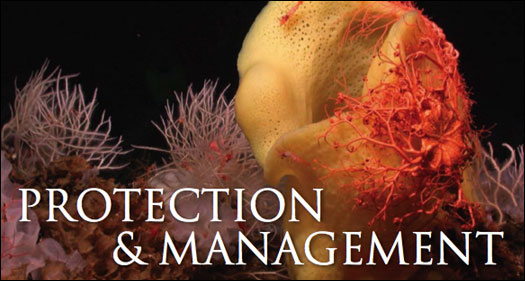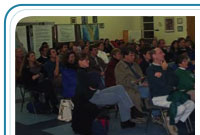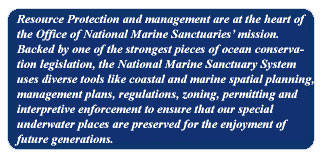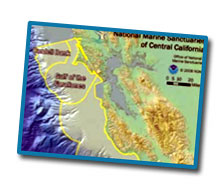
 |
 |  |
|
Protecting Your National Marine Sanctuaries |
 hrough the development and periodic review of sanctuary management
plans and regulations, the sanctuary
system works with partners, sanctuary advisory councils and the public to implement effective coastal and marine spatial planning. During the 2009 fiscal year, management
plans were completed for Gulf of the Farallones,
Cordell Bank, Monterey Bay, Channel Islands
and Thunder Bay national marine sanctuaries,
and the Papahānaumokuākea Marine National
Monument. Significant regulations passed dur
ing the year include the following: hrough the development and periodic review of sanctuary management
plans and regulations, the sanctuary
system works with partners, sanctuary advisory councils and the public to implement effective coastal and marine spatial planning. During the 2009 fiscal year, management
plans were completed for Gulf of the Farallones,
Cordell Bank, Monterey Bay, Channel Islands
and Thunder Bay national marine sanctuaries,
and the Papahānaumokuākea Marine National
Monument. Significant regulations passed dur
ing the year include the following:
 Final rules to implement the revised
management plans for Channel Islands,
Monterey Bay, Gulf of the Farallones
and Cordell Bank national marine sanctuaries, which included regulations to: Final rules to implement the revised
management plans for Channel Islands,
Monterey Bay, Gulf of the Farallones
and Cordell Bank national marine sanctuaries, which included regulations to:
- enhance protection for white sharks.
- reduce the potential for introduction
of non-native species.
- update vessel discharge regulations.
 Finalized revisions to Florida Keys National Marine Sanctuary regulations in
2009 to update the definition of coral to
include additional species and enhance
diving safety. Finalized revisions to Florida Keys National Marine Sanctuary regulations in
2009 to update the definition of coral to
include additional species and enhance
diving safety.
 Finalized, in coordination with the U.S.
Fish and Wildlife Service, the rule establishing a ship reporting system for the
Papahānaumokuākea Marine National
Monument. Finalized, in coordination with the U.S.
Fish and Wildlife Service, the rule establishing a ship reporting system for the
Papahānaumokuākea Marine National
Monument.
|
|
 |

Monterey Bay Sanctuary Extends Protection to Underwater Mountain
 Monterey Bay National Marine Sanctuary boundaries expanded in 2008 to include the Davidson Seamount, a pristine undersea mountain habitat off the coast of Central California, following seven years of extensive public input and inter-agency collaboration. At 26 miles long and
eight miles wide, it is one of the largest known seamounts in U.S. waters. From base to crest, it
is nearly 7,500 feet tall, yet its summit still lies more than 4,000 feet below the sea surface. The
seamount, which has been called an "oasis in the deep," is populated by diverse deep-sea corals, fish, crabs and sponges, including numerous rare and unidentified species. Davidson Seamount has special national significance for its ecological, scientific, educational and historical
qualities, and its inclusion in the Monterey Bay sanctuary is a triumph for ocean conservation. Monterey Bay National Marine Sanctuary boundaries expanded in 2008 to include the Davidson Seamount, a pristine undersea mountain habitat off the coast of Central California, following seven years of extensive public input and inter-agency collaboration. At 26 miles long and
eight miles wide, it is one of the largest known seamounts in U.S. waters. From base to crest, it
is nearly 7,500 feet tall, yet its summit still lies more than 4,000 feet below the sea surface. The
seamount, which has been called an "oasis in the deep," is populated by diverse deep-sea corals, fish, crabs and sponges, including numerous rare and unidentified species. Davidson Seamount has special national significance for its ecological, scientific, educational and historical
qualities, and its inclusion in the Monterey Bay sanctuary is a triumph for ocean conservation.
Papahānaumokuākea Nominated as a UNESCO World Heritage Site
In January 2009, Papahānaumokuākea Marine National Monument was nominated by the
United States for inscription as a World Heritage Site for its outstanding natural and cultural
attributes. The monument is one of only two sites nominated by the nation in more than 15
years. World Heritage listings are a designation of the United Nations Educational, Scientific
and Cultural Organization (UNESCO) and include sites such as the Egyptian pyramids and
the Grand Canyon. Papahānaumokuākea is currently being evaluated by UNESCO and will
come before the World Heritage Committee for decision in July 2010. Papahānaumokuākea is
the first site ever nominated with indigenous cultural connections to the sea. If inscribed to the
World Heritage List it would become one of the few marine conservation sites to receive this
level of recognition, and one of a handful of sites representing the heritage of Oceania.
Florida Keys Sanctuary Combats Illegal Poaching
Two of Florida's biggest lobster poaching busts on record came in 2009, both
taking place in Florida Keys National Marine Sanctuary. In two separate cases
built by sanctuary and state of Florida enforcement officers, poachers were
caught harvesting more than 10,000 pounds of lobster while diving on illegal
structures known as casitas, or "lobster condos." Casitas are artificial barriers on the seafloor that disrupt the natural migration of lobsters and cause
them to gather in places where they are subject to increased poaching and
predation. The structures also smother the seafloor underneath and have the
potential to damage the environment if displaced by storms. Over the last
three years, the NOAA Restoration Center, with support from the NOAA Marine Debris Program, the Florida Keys sanctuary, and other state and federal
agencies, oversaw a project that identified and removed 89 tons of casitas
and gear from sanctuary waters.
Global Connections Aid Marine Mammal Protection
The Hawaiian Islands Humpback Whale National Marine Sanctuary co-hosted the First International Conference on Marine Mammal Protected Areas in
Maui in spring 2009, bringing together marine protected area (MPA) managers and marine mammal experts from around the world. Although over 500
existing or proposed MPAs for marine mammals like whales and dolphins
span nearly 90 countries, there had never been a dedicated venue for collaboration and knowledge sharing among them. In an effort to bridge this
gap, more than 200 MPA managers, scientists and educators representing
40 countries gathered to discuss issues, establish valuable relationships and
explore effective approaches to marine management and conservation. Conference topics included whale sanctuaries, the role of culture in managing
MPAs, and the importance of education. Plans are already underway for the
next gathering, which will be hosted by France in 2011.
Sanctuaries, Partners Respond to Lionfish Threat
The first sighting of an Indo-Pacific lionfish in Florida Keys National Marine
Sanctuary waters was confirmed in January 2009. Around that time, ocean
users at Gray's Reef National Marine Sanctuary in Georgia also alerted sanctuary management to lionfish sightings in that area. This invasive, poisonous fish is a voracious predator with no natural predators in the Atlantic and
has potential to disrupt the fragile balance of sanctuary ecosystems. Both
sanctuaries worked with partners including agencies like NOAA's National
Centers for Coastal Ocean Science, non-profit organizations and the public
to implement a rapid response plan to help control the spread of this unwelcomed visitor. The plan included public outreach campaigns and training for
members of the dive and research communities in lionfish ecology and safe
capture techniques. In the Florida Keys, nearly 100 divers received permits
to capture and remove these fish from sanctuary preservation areas, which
are otherwise no-fishing zones. At Gray's Reef, two days were dedicated to
collecting lionfish at sites outside the sanctuary, and at one site 17 lionfish
were captured in 14 minutes.
|



